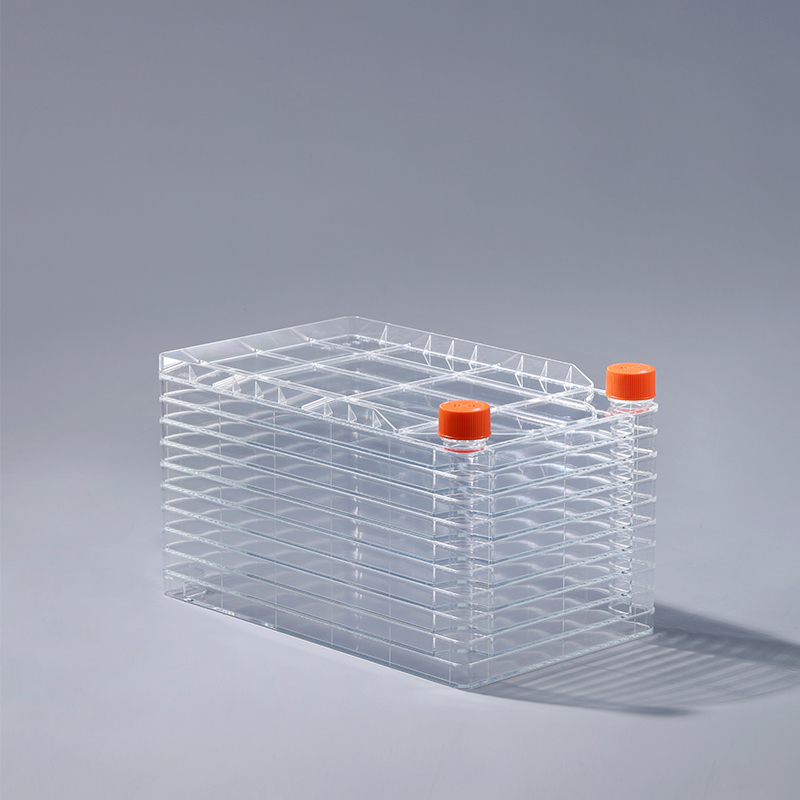är en cellodlingsanordning som är sammansatt av ett eller flera lager beroende på storleken på odlingsområdet, som kan realisera storskalig cellodling och är lämplig för många områden som vaccin, läkemedelsindustri eller monomer klon antikropp.Cellfabriken kan tillfredsställa adherent cellkultur, och den är också lämplig för statisk odling av suspensionsceller. Adherent odling innebär att cellerna måste fästas på väggen av odlingskärlet (flaskkärlet) när de odlas. När cellerna väl är fästa sprids de snabbt, börjar sedan mitos och går snabbt in i den logaritmiska tillväxtfasen. Generellt några dagar senare täcks odlingsytan och ett tätt cellmonoskikt bildas, såsom Vero-celler, HEK 293-celler, CAR-T-celler, MRC5, CEF-celler, grisalveolära makrofager, myelomceller, DF-1-celler, ST-celler, PK15-celler, Marc145-celler, etc. använder alla adherenta odlingsmetoder.cell factory
Suspensionskultur hänvisar till ett vävnadsodlingssystem som odlar enstaka celler och små cellkluster i ett flytande medium som ständigt skakas eller skakas. Tillväxten av suspenderade celler beror inte på underlagets yta och växer i suspenderat tillstånd i odlingsmediet. Till exempel används CHO-celler, insektsceller, BHK21-celler och MDCK-celler alla i suspensionskultur. dubbla behov av vidhäftande kultur och suspensionskultur, och gynnas av många vetenskapliga forskningsinstitutioner och läkemedelsföretag.
Suspension culture refers to a tissue culture system that cultivates single cells and small cell clusters in a liquid medium that is constantly agitated or shaken. The growth of suspended cells does not depend on the surface of the support, and grows in a suspended state in the culture medium. For example, CHO cells, insect cells, BHK21 cells and MDCK cells are all used in suspension culture.
The cell factory utilizes the advantages of multi-layer structure and large area, and is widely used in industrial mass production to meet the dual needs of adherent culture and suspension culture, and is favored by many scientific research institutions and pharmaceutical companies.
The FAI climbed 5.9 percent year-on-year in the first 11 months of 2018, quickening from the 5.7-percent growth in Jan-Oct, the National Bureau of Statistics (NBS) said Friday in an online statement.
The key indicator of investment, dubbed a major growth driver, hit the bottom in August and has since started to rebound steadily.
In the face of emerging economic challenges home and abroad, China has stepped up efforts to stabilize investment, in particular rolling out measures to motivate private investors and channel funds into infrastructure.
Friday's data showed private investment, accounting for more than 60 percent of the total FAI, expanded by a brisk 8.7 percent.
NBS spokesperson Mao Shengyong said funds into weak economic links registered rapid increases as investment in environmental protection and agriculture jumped 42 percent and 12.5 percent respectively, much faster than the average.
In breakdown, investment in high-tech and equipment manufacturing remained vigorous with 16.1-percent and 11.6-percent increases respectively in the first 11 months. Infrastructure investment gained 3.7 percent, staying flat. Investment in property development rose 9.7 percent, also unchanged.
 English
English



















































